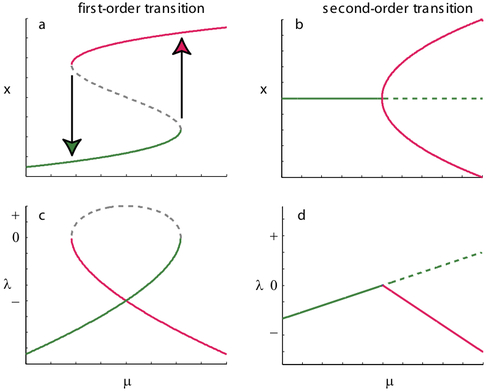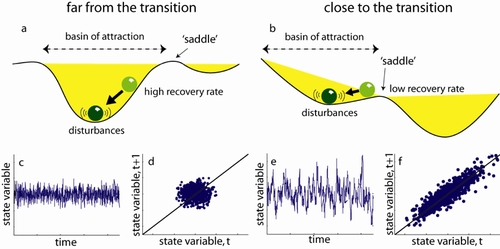Handling editor: Steve Schecter
Vasilis Dakos, Egbert van Nes, and Marten Scheffer,
Department of Aquatic Ecology and Water Quality Management
Wageningen University, The Netherlands
What do ecosystems, neuron cells and financial markets have in common?
They can all have tipping points at which sudden shifts to a different
regime occur. In the jargon of complex systems, such shifts are
considered to be critical transitions [MS1].
Such transitions are
often very important for humans: fisheries that collapse threaten
viable ecosystem services, neuron cells that fire in synchrony
lead to epileptic seizures, financial markets that crash leave
thousands of people unemployed.
Such critical transitions are ubiquous in a variety of complex
systems; transitions in earth systems, ocean circulation patterns, the
climate, human physiology, traffic jams, global finance are a few to
mention. In all cases predicting the critical threshold at which the
transition occurs is notoriously difficult, or considered
impossible. Models are usually not accurate enough to provide reliable
predictions. Thus it would be extremely useful to have empirical
indicators that can tell us whether we are approaching a transition
even in the absence of adequate knowledge about the mechanisms involved
[MS2].
Indicators of upcoming transitions: theoretical expectations
It is well known that in complex systems a continuous change in a
given parameter may sometimes lead to sudden changes in the behavior
of the system through bifurcation points [RS] (figure 1a, b). Such
bifurcations are usually associated with a vanishing dominant
eigenvalue of the stable equilibrium (zero-eigenvalue bifurcations
[SS], figure 1c, d). This implies that the system becomes increasingly
slow in recovering from perturbations close to the critical
point. Indeed, it can be shown that "critical slowing down" is a
generic phenomenon in the particular class of first-order (i.e. discontinuous) and second-order (i.e. continuous)
phase transitions and can be even found in other types of transitions
(like the Hopf bifurcation from a stable point to a limit cycle).

Figure 1. First-order discontinuous transition (a; fold bifurcation:
x'=-x3+β x+μ) and second-order continuous transition (b; pitchfork
bifurcation: x'= -x3+x μ). As the system approaches the bifurcation
point the dominant eigenvalue λ of the system goes to zero: the
fingerprint of "critical slowing down."
Direct consequences of
critical slowing down are [MS2]:
- Slow recovery from perturbations: The recovery rate after small
perturbations decreases when the system is close to the bifurcation
(figure 2a, d).
- Increasing autocorrelation: The state of the system
becomes more and more like its past state (figure 2c, f). The highly
correlated time series close to the transition can be quantified as an
increase in autocorrelation.
- Increasing variance: The
accumulating impact of the non-decaying shocks prior to the transition
increases the variance of the state variable (figure 2c, f).
- Increasing spatial coherence: Critical slowing down turns
spatially coupled units less reactive close to the
bifurcation. At this point diffusion between neighboring
units dominates. As a result, units tend to be in a state
similar to that of their neighbors. Such increasing coherence
is measured as increased spatial correlation.

Figure 2. Characteristic changes in the dynamics of a system towards a
first-order transition. a) Far from the transition a small
perturbation is fast absorbed within the symmetric basin of attraction
of the stable equilibrium. b) Close to the transition the system
recovers slowly upon a perturbation. As a result variance (c, e) and
autocorrelation (d, f) of the produced time series differ (modified
from [MS2]).
Transitions are not though only associated with vanishing
eigenvalues. They also are associated with multiple basins of
attraction that a system jumps to. Such attraction basins are
usually asymmetric close to the bifurcation, and are delimited by
saddle points which topologically may be seen as hills on stability
landscapes (figure 2a, d). Asymmetries and saddles can be also
related to transition indicators:
- Increasing skewness: In the vicinity of saddles the rates of
change are low (reflected in the asymmetry of the stability
landscape; figure 2d). The system spends more time close to
the saddle resulting in a highly skewed distribution of the
state variable.
- Flickering: The probability that stochastic forcing may temporarily
shift a system back and forth between alternative basins of
attraction is higher close to a bifurcation. As a result, the
variance and skewness of the frequency distribution of the
state variable increases.
- Spatial patterns: In a wider class of spatial systems, precursors of
critical transitions deviate from the above described general
patterns. Instead they are associated with specific
indicators, like self-organized pattern formation [MR],
changing scale-invariant power-law structures [SK], and
divergent order parameters [RS].
Can we monitor early-warning signals in real applications?
Most of the proposed leading indicators have been developed in simple
models and have not yet been tested in the field. Despite the optimism
that the few empirical successes inspire [e.g. VD], more work is
needed to test their applicability. Apparently, for any leading
indicator to be useful, some requirements are needed:
- It needs to be easily measured.
- It needs to be robust.
- It needs to be identified early enough to allow timely action.
The biggest challenge in the application of early-warning signals
comes from the difficulty in identifying the right variable to measure
and the right scale for monitoring that variable. In theory the
variable that will be the most reliable indicator would be the one
representing the fast component of the system (the variable that
actually shows that a transition has occurred; like the crashing
biomass of a fisheries). However in practice some variables will be
difficult or costly to measure at an adequate spatial or temporal
resolution. Failing to correctly identify and adequately sample the
right variables may lead to false negatives in recognizing upcoming
transitions.
A positive trend in the proposed leading indicators in real data may
not always be related to impending transitions. For instance a rare
external event may trigger a shift (false negative). Or a trend in the
external regime of perturbations may lead to false positives. The
robustness of the indicators may be further challenged by the fact
that there are multiple drivers that push the system not to a
singularly defined transition point but towards a moving
threshold. Perhaps tracking multiple indicators for multiple variables
(and drivers) may be a promising solution in building robust indicator
estimates.
All proposed early-warning signals are relative measures. They do not
predict when a transition occurs, but only indicate that the
likelihood of approaching a transition increases. This implies that it
is difficult to assess when an indicator actually signifies that the
fragility of the system is high that action is needed for
averting a transition. Such task becomes even more difficult given the
inertia of any system; intervention actions will only be successful if
they are fast and able to exercise influence on the fast components of
the system.
Looking forward
Early-warning signals are only indicative tools for
recognizing impending shifts. Specific knowledge of the system
dynamics, feedbacks and potential thresholds will always remain the
most important components in understanding and managing any
system. However the generic character of the early-warning signals
provides optimism about our potential ability to forecast critical
transitions.
References
| [MR] |
|
Rietkerk, M., S. C. Dekker, P. C. de Ruiter, and J. van de Koppel. 2004. Self-Organized Patchiness and Catastrophic Shifts in Ecosystems. Science 305:1926-1929.
|
| [MS1] |
Scheffer, M. 2009. Critical transitions in Nature and Society. Princeton University Press, Cambridge.
|
| [MS2] |
Scheffer, M., J. Bascompte, W. A. Brock, V. Brovkin, S. R. Carpenter, V. Dakos, H. Held et al. 2009. Early-warning signals for critical transitions. Nature 461:53-59.
|
| [RS] |
Solé, R.V., Manrubia, S.C., Luque, B., Delgado, J., and J. Bascompte. 1996. Phase transitions and complex systems. Complexity 1:13-26.
|
| [SK] |
Kefi, S., M. Rietkerk, C. L. Alados, Y. Pueyo, V. P. Papanastasis, A. ElAich, and P. C. de Ruiter. 2007. Spatial vegetation patterns and imminent desertification in Mediterranean arid ecosystems. Nature 449:213-217.
|
| [SS] |
Strogatz, S.H. 1994. Nonlinear Dynamics and Chaos with Applications to Physics, Biology, Chemistry and Engineering. Perseus Books.
|
| [VD] |
Dakos, V., Scheffer, M., van Nes, E.H., Brovkin, V., Petoukhov, V., Held, H. 2008. Slowing down as an early warning signal for abrupt climate change. Proc Natl Acad Sci U S A 105:14308-14312.
|